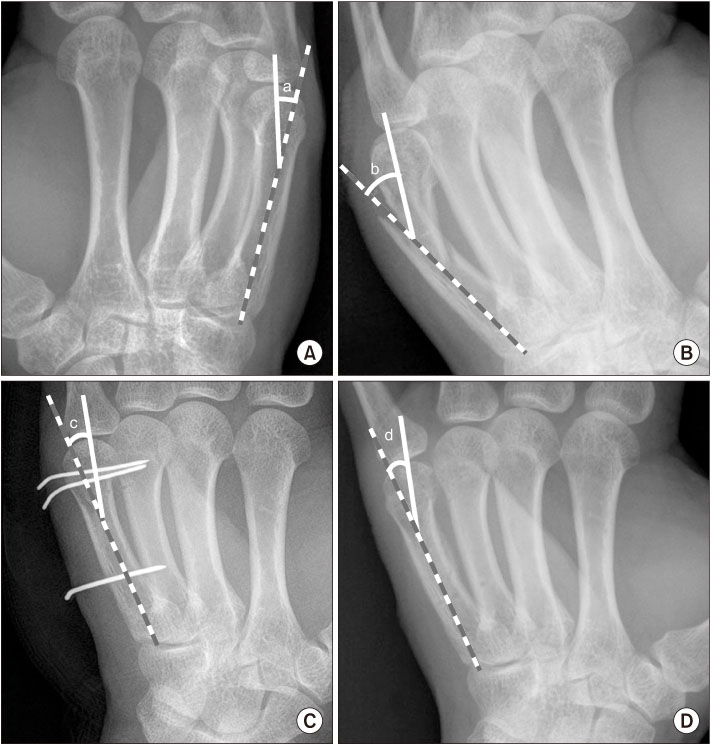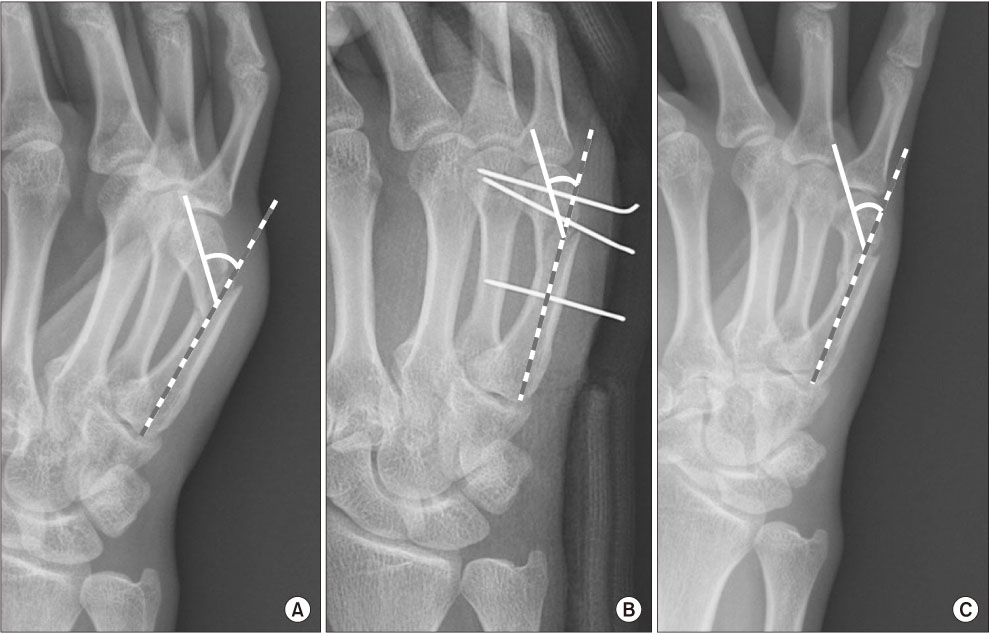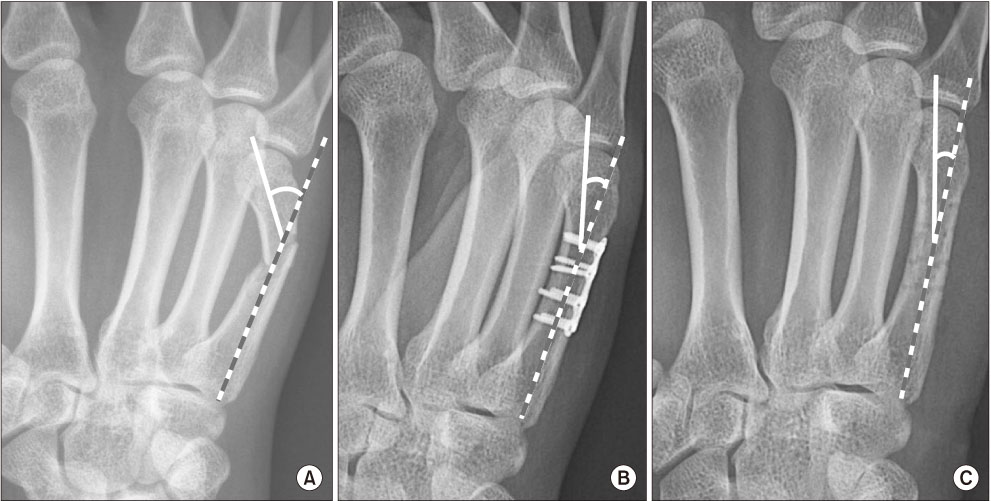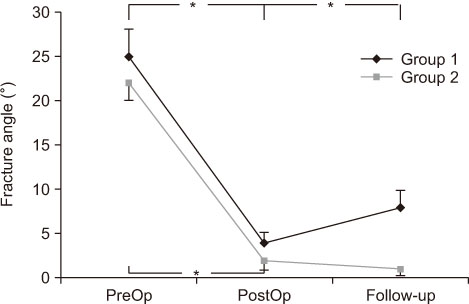Arch Hand Microsurg.
2018 Dec;23(4):230-238. 10.12790/ahm.2018.23.4.230.
Comparative Analysis of Fracture Angulation between Parallel Pinning and Plate Fixation Techniques in the Management of 5th Metacarpal Fractures
- Affiliations
-
- 1Department of Plastic and Reconstructive Surgery, Konkuk University School of Medicine, Seoul, Korea. sdhplastic@kuh.ac.kr
- KMID: 2427388
- DOI: http://doi.org/10.12790/ahm.2018.23.4.230
Abstract
- PURPOSE
Metacarpal fractures are common injuries of the hand. They are treated using closed reduction (CR) or open reduction (OR) techniques. The management strategy depends on fracture site characteristic and fixation methods. In this study, we evaluated pre- and postoperative fracture angulation, when metacarpal fractures bad been treated using two different techniques: CR with parallel transverse pinning and OR with plate fixation.
METHODS
Forty-six patients undergoing anatomic reduction to treat extra-articular metacarpal fractures were recruited. They were included in one of two therapeutic groups: Group 1, CR with parallel transverse pinning (n=21); Group 2, OR with plate fixation (n=25). Fracture angulation values have been measured on pre- and postoperative radiologic images. Values were compared between pre- and postoperative states, and between corresponding measurements of each group.
RESULTS
All extra-articular metacarpal fractures were successfully treated without wound related complications or the limit of joint motion. Both groups demonstrated adequate reduction at immediate postoperative period (postoperative angulation of group 1, 20°±7°; group 2, 19°±5°). During the observation at follow-up period, Group 1 exhibited slight recurrence (follow-up angulation of group 1, 24°±10°). Nonetheless, Group 2 showed adequate reduction state in both immediate postoperative and long-term follow-up periods (follow-up angulation of group 2, 18°±6°).
CONCLUSION
Extra-articular metacarpal fractures were successfully restored without functional complications. CR with parallel transverse pinning method exhibited recurrence after pin removal, which necessitates cautious postoperative exercise and monitoring.
MeSH Terms
Figure
Reference
-
1. Kim JK, Kim DJ. Antegrade intramedullary pinning versus retrograde intramedullary pinning for displaced fifth metacarpal neck fractures. Clin Orthop Relat Res. 2015; 473:1747–1754.
Article2. Reformat DD, Nores GG, Lam G, et al. Outcome analysis of metacarpal and phalangeal fixation techniques at Bellevue hospital. Ann Plast Surg. 2018; 81:407–410.
Article3. Strauch RJ, Rosenwasser MP, Lunt JG. Metacarpal shaft fractures: the effect of shortening on the extensor tendon mechanism. J Hand Surg Am. 1998; 23:519–523.
Article4. Beutel BG, Ayalon O, Kennedy OD, Lendhey M, Capo JT, Melamed E. Crossed K-wires versus intramedullary headless screw fixation of unstable metacarpal neck fractures: a biomechanical study. Iowa Orthop J. 2018; 38:153–157.5. Bao B, Zhu H, Zheng X. Fourth and fifth carpometacarpal fracture-dislocations is plate or Kirschner wire fixation superior: a retrospective cohort study. Int J Surg. 2018; 52:293–296.6. Biz C, Iacobellis C. Comparison of percutaneous intramedullary Kirschner wire and interfragmentary screw fixation of displaced extra-articular metacarpal fractures. Acta Biomed. 2014; 85:252–264.7. Botte MJ, Davis JL, Rose BA, et al. Complications of smooth pin fixation of fractures and dislocations in the hand and wrist. Clin Orthop Relat Res. 1992; 194–201.
Article8. Sletten IN, Nordsletten L, Hjorthaug GA, Hellund JC, Holme I, Kvernmo HD. Assessment of volar angulation and shortening in 5th metacarpal neck fractures: an interand intra-observer validity and reliability study. J Hand Surg Eur Vol. 2013; 38:658–666.9. Horton TC, Hatton M, Davis TR. A prospective randomized controlled study of fixation of long oblique and spiral shaft fractures of the proximal phalanx: closed reduction and percutaneous Kirschner wiring versus open reduction and lag screw fixation. J Hand Surg Br. 2003; 28:5–9.
Article10. Pandey R, Soni N, Bhayana H, Malhotra R, Pankaj A, Arora SS. Hand function outcome in closed small bone fractures treated by open reduction and internal fixation by mini plate or closed crossed pinning: a randomized controlled trail. Musculoskelet Surg. 2018; DOI: 10.1007/s12306-018-0542-z. [Epub ahead of print].
Article11. Freeland AE, Orbay JL. Extraarticular hand fractures in adults: a review of new developments. Clin Orthop Relat Res. 2006; 445:133–145.12. Greeven AP, Bezstarosti S, Krijnen P, Schipper IB. Open reduction and internal fixation versus percutaneous transverse Kirschner wire fixation for single, closed second to fifth metacarpal shaft fractures: a systematic review. Eur J Trauma Emerg Surg. 2016; 42:169–175.
Article13. Lutz M, Sailer R, Zimmermann R, Gabl M, Ulmer H, Pechlaner S. Closed reduction transarticular Kirschner wire fixation versus open reduction internal fixation in the treatment of Bennett’s fracture dislocation. J Hand Surg Br. 2003; 28:142–147.14. Kawamura K, Chung KC. Fixation choices for closed simple unstable oblique phalangeal and metacarpal fractures. Hand Clin. 2006; 22:287–295.
Article15. Gülke J, Leopold B, Grözinger D, Drews B, Paschke S, Wachter NJ. Postoperative treatment of metacarpal fractures-classical physical therapy compared with a home exercise program. J Hand Ther. 2018; 31:20–28.
Article16. Watt AJ, Ching RP, Huang JI. Biomechanical evaluation of metacarpal fracture fixation: application of a 90° internal fixation model. Hand (N Y). 2015; 10:94–99.
Article17. Skirven TM, Osterman AL, Fedorczyk J, Amadio PC. Rehabilitation of the hand and upper extremity, 2-volume set E-book: expert consult. Amsterdam: Elsevier Health Sciences;2011.18. Chiu YC, Tsai MT, Hsu CE, Hsu HC, Huang HL, Hsu JT. New fixation approach for transverse metacarpal neck fracture: a biomechanical study. J Orthop Surg Res. 2018; 13:183.
Article19. Lee DH, Park JW, Lee JI. Irreducible metacarpal neck fracture caused by interposition of junctura tendinum. Hand Surg. 2014; 19:441–443.
Article
- Full Text Links
- Actions
-
Cited
- CITED
-
- Close
- Share
- Similar articles
-
- Treatment of 5th Metacarpal Neck Fracture Using Percutaneous Transverse Fixation with K-Wires
- The 5th Metacarpal Neck Fracture Treated by Closed Reduction and Percutaneous Intramedullary K-wire Fixation
- Antegrade Intramedullary Prebent K-wire Fixation for the 5th Metacarpal Neck Fracture
- Bouquet Pin Intramedullary Nail Technique of the 5th Metacarpal Neck Fractures
- Operative Treatment of Metacarpal Shaft Fracture>: Comparision of Low-Profile Miniplating System and Kirschner Wire Fixation





